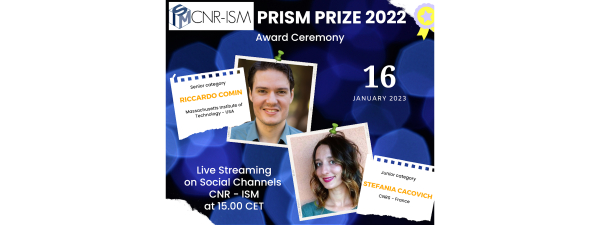15:00 Welcome of the CNR President, Prof. Maria Chiara Carrozza and introduction to the CNR Relaunch Plan
15:10 The PRISM prize (Prof. A. Di Carlo - Director of CNR-ISM)
15:15 Multidimensional Photoluminescence Analysis for Photovoltaic Materials and Devices, Dr. Stefania Cacovich, Unité Mixte de Recherche CNRS-IPVF (France)
15:45 Singular Bands in a Kagome-Lattice Superconductor, Prof. Riccardo Comin - Massachusetts Institute of Technology (USA)
16:15 Award ceremony
16:30 Conclusion
Abstract
Multidimensional Photoluminescence Analysis for Photovoltaic Materials and Devices
Stefania Cacovich
Institut Photovoltaïque d’Île de France (IPVF), CNRS, Palaiseau, 91120, France
Photovoltaic (PV) devices offer a direct conversion of light source into electricity, providing a much-needed solution to meet climate targets and move towards a low-carbon economy. In the solar cell community there is a growing interest in the use and in the optimisation of optical imaging techniques, mainly based on luminescence analysis. Being contactless and non-destructive, they can be used at different steps of the life cycle of a solar cell, from the growth (in-situ) to the use (operando). Therefore, they constitute a powerful tool for characterizing charge transport mechanisms, allowing a direct access to the local photophysical properties of materials and devices.
During the past few years, hybrid perovskite solar cells have attracted a considerable amount of research and have undergone rapid development as next generation photovoltaics [1]. This emergent class of solar cells have become increasingly popular due to the opportunity of reaching high power conversion efficiency, while retaining a low manufacturing cost. In this talk, I will present how steady-state and time-resolved multidimensional photoluminescence imaging techniques can be used to probe the main optoelectronic and transport properties of perovskite thin films and full devices. A particular focus will be given to materials stability [2], and to new strategies envisaging the introduction of passivating agents based on organic cations at solar cells interfaces resulting in record efficiencies up to a value of 23.7%3 in p-i-n devices [3].
[1] N.-G. Park, M. Grätzel, T. Miyasaka, K. Zhu, K. Emery, Nat. Energy 2016, 1, 1652.
[2] S. Cacovich, D. Messou, A. Bercegol, S. Béchu, A. Yaiche, H. Shafique, J. Rousset, P. Schulz, M. Bouttemy, L. Lombez, ACS Appl. Mater. Interfaces 2020, 12, 34784.
[3] S. Cacovich et al. Imaging and Quantifying non-radiative Losses at 23% Efficient Inverted Perovskite Solar Cells Interfaces. Nat. Comm. 2022, 13 (1), 1-9.
Singular bands in a kagome-lattice superconductor
Riccardo Comin
Dept. of Physics, Massachusetts Institute of Technology, Cambridge, MA, USA
The layered vanadium antimonides AV3Sb5 (A = K, Rb, Cs) are a new family of topological kagome metals that exhibit a range of strongly correlated electronic phases including charge order and superconductivity [1]. If and how the distinctive electronic structure of the kagome lattice is linked to these broken-symmetry phases is a matter of active debate. I will discuss our observation of multiple kagome-derived van Hove singularities (vHS) coexisting near the Fermi level of CsV3Sb5 and examine their role toward electronic symmetry breaking [2]. The vHS are characterized by two distinct sublattice flavors (p-type and m-type), with the m-type vHS (from V 3dxz/3dyz orbitals) and the p-type vHS (from V 3dxy/3dx2–y2 orbitals) being located very close to the Fermi level, setting the stage for electronic symmetry breaking. The former band exhibits pronounced Fermi surface nesting, however, it is the latter that exhibits the largest gap, revealing a strong-coupling origin of charge order. This work highlights the role of kagome-derived vHS for the collective phenomena realized in the AV3Sb5 family.
[1] Ortiz, B. R., et al., Phys. Rev. Mater. 3, 94407 (2019); Ortiz, B. R., et al., Phys. Rev. Lett. 125, 247002 (2020).
[2] M. Kang, et al., Nature Physics 18, 301 (2022).


 English (UK)
English (UK)  Italiano (Italia)
Italiano (Italia)